
Kaimanawa horses are a population of feral horses in New Zealand that are descended from domestic horses released in the 19th and 20th centuries. They are known for their hardiness and quiet temperament. The New Zealand government strictly controls the population to protect the habitat in which they live, which includes several endangered species of plants. The varying heritage gives the breed a wide range of heights, body patterns and colours. They are usually well-muscled, sure-footed and tough.

The Exmoor Pony is a British breed of pony or small horse. It is one of the mountain and moorland pony breeds native to the British Isles, and so falls within the larger Celtic group of European ponies. It originates on, and is named for, the Exmoor area of moorland in north-eastern Devon and western Somerset, in south-west England, and is well adapted to the climate conditions and poor grazing of the moor. Some still live there in a near-feral state, but most are in private ownership.

The Welsh Pony and Cob is a group of four closely-related horse breeds including both pony and cob types, which originated in Wales. The four sections within the breed society for the Welsh breeds are primarily distinguished by height, and also by variations in type: the smallest Welsh Mountain Pony ; the slightly taller but refined Welsh Pony of riding type popular as a children's show mount; the small but stocky Welsh Pony of Cob Type, popular for riding and competitive driving; and the tallest, the Welsh Cob, which can be ridden by adults. Welsh ponies and cobs in all sections are known for their good temperament, hardiness, and free-moving gaits.

The Pottok or Pottoka, is an endangered, semi-feral breed of pony native to the Pyrenees of the Basque Country in France and Spain.

The Nokota horse is a feral and semi-feral horse breed located in the badlands of southwestern North Dakota in the United States. The breed developed in the 19th century from foundation bloodstock consisting of ranch-bred horses produced from the horses of local Native Americans mixed with Spanish horses, Thoroughbreds, harness horses and related breeds. The Nokota was almost wiped out during the early 20th century when ranchers, in cooperation with state and federal agencies, worked together to reduce competition for livestock grazing. However, when Theodore Roosevelt National Park was created in the 1940s, a few bands were inadvertently trapped inside, and thus were preserved.

A brumby is a free-roaming feral horse in Australia. Although found in many areas around the country, the best-known brumbies are found in the Australian Alps region. Today, most of them are found in the Northern Territory, with the second largest population in Queensland. A group of brumbies is known as a "mob" or "band".

A semi-feral animal lives predominantly in a feral state but has some contact and experience with humans. This may be because it was born in a domesticated state and then reverted to life in wild conditions, or it may be an animal that grew up in essentially wild conditions but has developed a comfort level with humans through feeding, receiving medical care, or similar contacts.
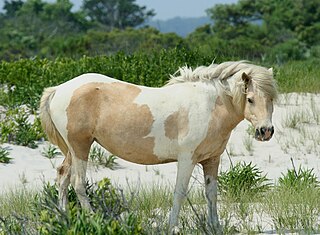
The Chincoteague pony, also known as the Assateague horse, is a breed of horse that developed, and now lives, within a semi-feral or feral population on Assateague Island in the US states of Virginia and Maryland. The Chincoteague pony is one of the many breeds of feral horses in the United States. The breed was made famous by the Misty of Chincoteague novels, written by pony book author Marguerite Henry, and first published in 1947, and the pony Misty of Chincoteague.
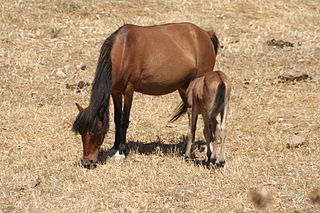
The Skyrian Horse is a breed of miniature horse found on the Greek isle of Skyros.
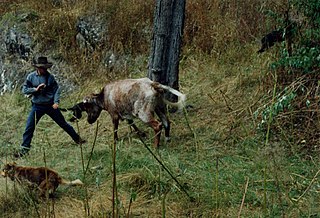
A muster (Au/NZ) or a roundup (US/Ca) is the process of gathering livestock. Musters usually involve cattle, sheep or horses, but may also include goats, camels, buffalo or other animals. Mustering may be conducted for a variety of reasons including routine livestock health checks and treatments, branding, shearing, lamb marking, sale, feeding and transport or droving to another location. Mustering is a long, difficult and sometimes dangerous job, especially on the vast Australian cattle stations of the Top End, 'The Falls' (gorge) country of the Great Dividing Range and the ranches of the western United States. The group of animals gathered in a muster is referred to as a "mob" in Australia and a "herd" in North America.

A feral horse is a free-roaming horse of domesticated stock. As such, a feral horse is not a wild animal in the sense of an animal without domesticated ancestors. However, some populations of feral horses are managed as wildlife, and these horses often are popularly called "wild" horses. Feral horses are descended from domestic horses that strayed, escaped, or were deliberately released into the wild and remained to survive and reproduce there. Away from humans, over time, these animals' patterns of behavior revert to behavior more closely resembling that of wild horses. Some horses that live in a feral state but may be occasionally handled or managed by humans, particularly if privately owned, are referred to as "semi-feral".

The Lundy Pony is a British breed of pony bred on Lundy Island in the twentieth century.
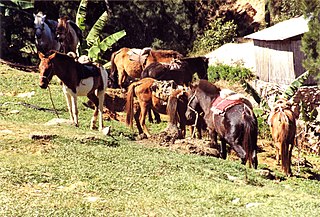
The Timor Pony was developed on Timor Island, likely from Indian breeds of horses and ponies that were imported to the island. The Timor Pony is thought to be closely related to the Flores Pony, which was developed on nearby Flores Island. Both breeds are used by the local people for cattle work, as well as riding, driving, and light farm work. Many of these ponies have been exported to Australia, where they have had an influence on the breeding of the Australian Pony.
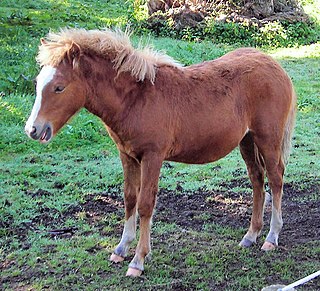
The Kerry Bog Pony is a mountain and moorland breed of pony that originated in Ireland. Possibly descended from the Irish Hobby horse, it originally lived a mainly feral existence in the peat bogs of what is now County Kerry in southwestern Ireland. Local inhabitants used the ponies as pack and cart horses for transporting peat and kelp to the villages. The breed developed physical characteristics including a low weight-to-height ratio and an unusual footfall pattern, which helped it move on soft ground such as peat bogs. The ponies were known for hardiness and an ability to survive in harsh conditions.
The Banker horse is a breed of semi-feral or feral horse living on barrier islands in North Carolina's Outer Banks. It is small, hardy, and has a docile temperament, and is genetically related to the Carolina Marsh Tacky of South Carolina and Florida Cracker Horse breeds through their shared Colonial Spanish horse and Iberian horse descent. The current population of wild Banker horses is estimated to be about 400.
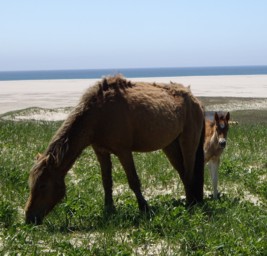
The Sable Island horse is a small feral horse found on Sable Island, off the coast of Nova Scotia, Canada. It has a horse phenotype and horse ancestors, and is usually dark in colour. The first horses were released on the island in the late 1700s, and soon became feral. Additional horses were later transported to improve the herd's breeding stock. They were rounded up for private use and sale for slaughter, which by the 1950s had placed them in danger of extinction. During the 2018 study, the estimated population was 500 horses, up from the roughly 300 recorded in the 1970s.
Brumby shooting or brumbies shooting is the practice of eradicating feral horses, or "brumbies", in Australia. It has been conducted since the 1800s, and continues into the present day. The term "brumby" was first recorded in the 1870s. Reasons for brumby shooting include, but are not limited to: demands for grazing land and water for domestic herds, sport, to maintain pastoral stations, to reduce environmental damage caused by the horses, to control disease, and to prevent possible road collisions.

The Lac La Croix Indian Pony (LLCIP), also known as the Ojibwe pony is a semi-feral Canadian horse breed developed by the Ojibwe people. The population became critically low; and, by 1977, only four mares remained. To preserve the breed, these mares were crossed with Spanish Mustang stallions. The modern breed name derives from the Lac La Croix First Nation of Ontario, where the horses were last found in the wild. Historically, the breed was also found in Minnesota.

Carneddau ponies are a breed of small Welsh Mountain ponies, present in the Carneddau mountains in north Wales, in Snowdonia (Eryri). They stand at 10-11 hands, and in 2013, DNA identification revealed that they are a distinct, unique and ancient breed having been isolated in the Carneddau for centuries. "A study of their DNA shows they have been isolated for at least several hundred years, according to researchers at Aberystwyth University." "Clare Winton, an IBERS post-graduate student who performed the study as part of her Ph.D thesis revealed: “Although the Carneddau ponies have shared ancestry with the Welsh Section A pony, they exhibit genetic signatures such as unique mutations while maintaining high genetic diversity, demonstrating that the population has been isolated for at least several hundred years. Therefore, the Carneddau ponies are a genetically distinct population.”
















